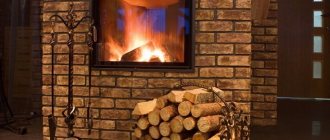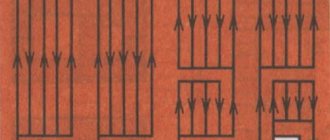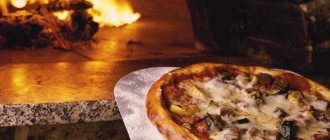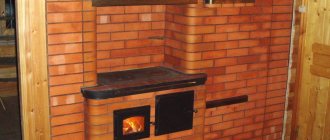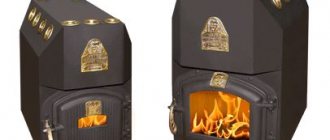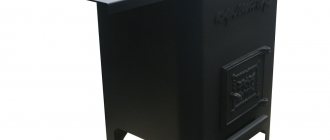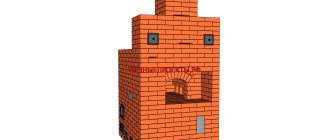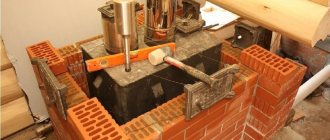Schemes and types
Graphic materials on the series of ovens PROFESSOR BUTAKOV:
Features of the
Furnaces PROFESSOR BUTAKOV are designed for economical air heating of premises with a maximum volume of 150 to 1200 cubic meters. Furnaces PROFESSOR BUTAKOV are marked by consumer properties superior to all existing analogues. The maximum volume of the heated room is determined for each model of PROFESSOR BUTAKOV stoves based on the conditions for ensuring effective convection heat transfer and the standards for the total thermal resistance of the enclosing structures according to SNiP II-3-79 (for residential premises in the Moscow region 3.2 m2 x C ° / W). The manufacturers carried out a deep study of the heat engineering characteristics, paid attention to the ergonomics, compactness and reliability of the PROFESSOR BUTAKOV ovens. Prototypes of air-heating boilers PROFESSOR BUTAKOV have successfully passed two-year tests at real facilities in Western Siberia and passed state certification. The area of heating surfaces of the PROFESSOR BUTAKOV furnaces, one side in contact with the flame, and the other with the air of the heated room, is a record developed area. A large sealed firebox and a secondary combustion system make it possible to effectively use the PROFESSOR BUTAKOV stove in the long burning mode. Convective heat exchange tubes are directly in the flame along the entire cross-section and along the entire length, from start to finish. The firebox is relatively long, high, not wide and truncated at the top. This shape most closely matches the shape of the thermal diagram of a freely combustible solid fuel. The front and rear surfaces, on which the convective pipes are placed, fully participate in convective heat transfer. The flow of flame and hot flue gases is directed along the convective pipes, from their very beginning to their very end. On the upper horizontal surface of the PROFESSOR BUTAKOV oven, in contact with the flame, you can warm up or even cook food. The large replaceable grate ensures even burning. If necessary, it allows you to sharply accelerate the combustion to quickly raise the temperature or dry the raw fuel. The capacious pull-out ash drawer allows one movement, without interrupting the combustion, to remove the ash. The inlets of convective heat exchange tubes are located at a considerable distance from the floor, which is favorable for air circulation. Heating stove PROFESSOR BUTAKOV has a stable base with holes for additional fastening to the floor. To install the PROFESSOR BUTAKOV oven, no additional bases or podiums are required.
Price lists
Quick access to prices for the entire range of Pechki-Lavochki products.
In Russia, furnaces developed by Professor Butakov are in great demand. A distinctive feature of the heating device is that it heats up in a short time room with a large area
, while fuel consumption is minimal. The equipment has good aesthetic characteristics, so it will not spoil the appearance of the room. This design
you can do it yourself
.
Design
The furnace includes convective pipes, which are installed according to the scheme. Unlike its counterparts, Butakov's stove has a high heat transfer.
The apparatus consists of simple parts
:
- ash pan;
- fuel compartment;
- grate;
- chimney;
- pipes for air flow circulation
.
In order to use the maximum thermal energy, the fuel compartment is made in the shape of a parallelepiped.The pipe for this section should only be fixed vertically. On the pipe for air circulation, at a height of 12 centimeters from the footrests, you need to make horizontal cuts. This is necessary in order for the air to flow into the generator.
Also in the oven there must be an ash pan
, in which combustion waste is collected. One bookmark is enough for about 10 hours of heating the room. Also, the duration of work depends on a certain
heating unit models
.
Summarizing
Using Butakov's heating stove does not have to be an alternative. The decision, made initially, to heat your home with this particular unit will not disappoint your expectations. The quiet crackling of wood and the soft reflections of the flame in the glass door will create a unique aura of comfort, and the “omnivorousness” of the stove will allow you not to get hung up on one type of fuel.
The video proposed in the video will help you to understand the subtleties of adjusting the smoldering-combustion process.
Did you like the article? Subscribe to our channel Yandex.Zen
Varieties of ovens
Butakov's devices are produced in several models. It is important to note that all furnace options operate according to the same principle, and also have the same design
... Models differ in power, dimensions, number of pipes. Therefore, you can easily select the unit for any room. Existing models:
- "High school student". This design is no longer available on an industrial scale, since it is ineffective
. - "Student". The stove can heat a room with with an area of 150 m3
... It is an excellent option for living quarters. - Engineer model. The design is capable heat 250 m3
. - "Associate Professor" is designed for a room with with an area of 500 m3
. - “Professor” will heat 1000 m3.
- "Academician".
On some structures, a hob is installed for cooking.
Stove "Student"
This heating device is the best option for a living space, since it has a small size, attractive appearance
, and is capable of heating a room with a large area.
The weight of the structure is 70 kilograms
, fuel compartment
equals 60 liters
.
Traditional units have a double furnace door, the outer one acts as a protection. The “Student” design is provided with a special cast iron door with an inspection window made of fireproof glass. It should be noted that the window will turn black over time, so you do not need to install it.
The unit can purchase ready-made with the necessary components
... Depending on the store, this stove may cost,
approximately 20,000 rubles
.
Installation of the "Student" oven
The structure can be assembled by hand, in several stages
:
- First of all, it is recommended to prepare an assembly drawing or download a ready-made version on the Internet. This will make the job easier.
- Then you should prepare a place for the structure. The surface of the floor and walls must be finished with refractory materials.
- Decide on pipe outlet section
... Then make a hole in the ceiling, which is covered with non-combustible materials. - Then the unit is installed on prepared stand
. - With the help of a sealant they are mounted all pipes in sequence
... It is recommended to purchase sandwich pipes that prevent the formation of condensation and the penetration of smoke into the room. - Outside on the pipe, you need to make a special "skirt".
If the student is installed on a small distance from wooden parts and surfaces
, then the walls must be covered with asbestos cardboard. It is recommended to fix galvanized sheets from above.
You need to carefully make a hole for the pipe in the ceiling. It should be several centimeters larger than the chimney diameter. The hole that has been made must also be covered with refractory materials, as this area is hazardous.The stove "Student" does not contain a water tank, but if you need hot water in the house, you can additionally buy the necessary capacity. To do this, you need to carefully connect the pipes, container and gate. All joints must be carefully sealed.
After all the accessories of the device “Student"
will be collected, you need to check the oven and light it up. It should be noted that the first ignition implies
large indoor smoke
, as paints and various oils will fade. It is therefore recommended to start the heater for the first time.
spend outdoors
... If no defects are found, then you can install the structure "Student" in the room.
Advantages and disadvantages
Numerous reviews on the Internet indicate that the Engineer oven has a number of advantages and disadvantages.
On the positive side, consumers include:
- beautiful and original design;
- with a large weight, but due to their small size, these ovens take up little space;
- rapid heating of the air in the room (however, like all metal stoves);
- through the existing air ducts, hot air coming from the side convection pipes can heat adjacent rooms;
- high efficiency, including due to the fact that, due to the design features, all surfaces of the furnace participate in heating the room;
- the ability to regulate fuel consumption;
- low price (unlike, for example, the cost of gas-fired heating equipment).
Another oven, Buleryan, has similar advantages. More details here:
Among the main disadvantages are:
- fast burning of firewood and, accordingly, rather rapid cooling of the stove and premises;
- despite the presence of a chimney, the stove sometimes smokes, the doors are covered with soot (especially visible on the glass) and the chimney;
- the stove heats up very much, so there is a possibility of getting burns when touching it, ruining the floor and walls.
Perhaps the article on Finnish stoves and fireplaces will be useful to you.
Read the article on making a pyrolysis oven with your own hands here.
Furnace "Engineer"

At the beginning of the century, Professor Butakov developed a new model of a heating device. This unit is in demand among the population. The stove is capable of heating a room with an area of up to 2500 m3. As fuel you can use firewood, cardboard, peat and coal
... The oven operates at a temperature
range -55 - +40 degrees
... Small size allows you to install the structure in any convenient place.
"Engineer" is used to heating of residential premises, garages, greenhouses, industrial warehouses, small stations
... It should be noted that this model of the furnace has a high price - more
30,000 rubles
... You can make such a stove with your own hands.
Furnace design:
- case with two cameras;
- the required number of built-in pipes;
- grate;
- firebox;
- ash pan;
- eyeliner.
It is important to note that the fuel in the device does not burn, but slowly smolders, which allows you to save fuel consumption and increase the degree of heat transfer. The internal temperature should not exceed 350 degrees. The first start-up should take about two hours in combustion mode.
Advantages of the "Engineer" apparatus:
- heats a large room;
- one fuel tab is enough for 10 hours;
- convective pipes increase the efficiency;
- warms up evenly;
- thanks to the ash pan, the drawer can be emptied at any time.
Cons of the unit:
- excess air enters the furnace through the ash pan;
- to clean do it yourself pipe
, you need to disassemble it into sections; - front panel over time deforms
.
Furnace installation process:
- Find a suitable installation site and cover the floor with asbestos and 10mm metal sheet.
- If there are walls nearby, then they also need to be insulated with.
- Place a sheet in front of the machine made of metal.
- Insulate the opening in the ceiling.
- It is recommended to install the stove on a brick base.
- Connect all pipe sections and lead out.
- The chimney must be located on the roof at a height of at least 50 centimeters.
In St. Petersburg and the Leningrad region
1. Delivery is carried out with an order amount of more than 15 thousand rubles (when ordering for an amount less than 15 thousand rubles - negotiated individually)
2. We deliver goods to customers from Monday to Saturday from 10:00 to 20:00 (in the region from 11:00 to 20:00) within 2 working days, subject to the availability of all the necessary goods in stock. If the item you have selected is not in the main warehouse, the delivery time may slightly increase.
3. Delivery is carried out to the entrance. Unloading is carried out by your forces, if not formalized
Unloading cost
- Goods up to 100 kg - 3000 rubles. *
- Goods up to 200 kg - 5000 rubles. *
- Over 200 kg - by agreement *
* Unloading means removing the goods from the car and bringing them to the ground floor to the place of installation.
Check the final cost with the manager. (The cost may be influenced by the following factors: inconvenient approach to the unloading point, long transport distance and long waiting times for unloading)
4. Tariffs for delivery to the entrance:
Within the ring road:
- with the purchase amount
over 30,000 rubles.
- delivery
IS FREE
... - with the purchase amount
up to 30,000 rubles.
, cost of delivery -
1200 RUB
* delivery in the Central District - 1500 rubles
Outside the ring road:
additionally for each 1 km from the ring road - 30 rubles / km
Delivery to Vasilievsky Island is temporarily suspended
Oven with a water circuit
It is not necessary to assemble the oven with your own hands, you can purchase a ready-made option from the developer Butakov
.
Benefits:
- Despite the fact that you have to tinker with the water circuit, such a stove is much cheaper than autonomous heating.
- The device can be connected to another heating system.
- The use of various types of solid fuels.
- Excellent aesthetic qualities.
With the onset of the autumn-winter period, the owners of summer cottages, country houses and cottages have new problems - how to provide warmth in the house, as one of the components of a comfortable stay for family members, to prevent freezing of communications.
Modern industry offers a large assortment of different types of heating systems, among which there is a series of metal "Professor Butakov" (named by the inventor S.A. Butakov - a heating scientist in honor of his grandfather), the manufacturer of which is a Siberian one.
The range of stoves is represented by 6 models with original names and intended for heating rooms of various volumes:
- for small country houses 100-150 cubic meters in size. - "gymnasium student", "Student", with a rated power of 6 and 9 kW;
- for a large country house with babout
the largest volume of premises - up to 250 cubic meters. - "Engineer", with a capacity of 15 kW; - for cottages, industrial premises (hangars, building change houses) 500-1000-1200 cubic meters. - "Associate Professor", "Professor", "Academician", with a capacity of 25-40-55 kW, respectively.
The Butakova Engineer oven is very popular among the owners of country houses, mainly, and small industrial premises.
Device
Watch a video in which an experienced user demonstrates the design features of the "Professor Butakov - Engineer" heating furnace:
Professor Butakov's ovens are very popular in Russia.
They are capable of incredibly quickly heating any room, which speaks of the power of the product.
But the oven operates in a very economical mode.
Suffice it to say that to heat a room, of course, of the same volume, a given stove requires half as much fuel as compared to and almost 12 times (!) Less than a "potbelly stove".
It is curious that it is the "potbelly stove" that is the prototype of Butakov's gas-generating furnaces.
The product runs on solid fuel. The following can be used as fuel:
- pressed paper
- leftover cardboard
- firewood
- fine coal.
The ideal option for using Butakov's stove is in the country, to which it is impossible or unprofitable to carry out electric or gas heating.
Butakov's stoves are practical and quite convenient to use:
- in various warehouses
- for or basements
- various hangars
- construction change houses
- mobile stations
- other technical rooms.
The principle of operation of this oven is as follows: being generated through the lower holes, the air flow, warming up in the oven, enters the room through the upper holes.
Fuel smolders, not burns, because it is subject to a pyrolysis process. The minimum oxygen content leads to thermal decomposition of the fuel.
Butakov's stoves are long burning stoves.
The design of Professor Butakov's heating furnaces is very simple. It consists of:
- Two-chamber firebox (gasification, afterburning);
- Ash pan (for the remains of the used product);
- The grate (this is a damper located between the firebox and the ash pan);
- Air pipes;
- Chimney.
As you can see, nothing new, but the scientist Butakov, taking into account the shortcomings of similar previous designs, managed to eliminate heat loss by increasing the heat transfer of his products to 85%.
All models of Butakov's stoves have a single purpose, the same operating principle, identical design and common fuel. They differ in size, power, number of pipes and their diameters and volumes of heated rooms.
The series is represented by six models. The most compact of them, “Gymnazist”, is made to order, the rest are serially produced. In this article, we will look at three models in this series.
The upper part of the oven is designed for full cooking (heating) food. There are modifications with glass.
In addition, the Student stove can be equipped with a cast iron door or equipped with a steel door.
The 70-kilogram stove has a power of 9 kW, which allows heating rooms up to 150 cubic meters. meters. The chimney diameter is 120 mm, and the maximum fuel loading volume is 20 liters.
Device and principle of operation


The air in the pipes heats up and rises, ensuring uniform heating of the room
The basis for Butakov's designs is a welded body with built-in pipe channels, inside of which convection processes take place. In this case, cold air enters through the pipe system, and then heats up in the housing and already hot air goes out through the upper outlet. Then it spreads throughout the heated room, bringing the temperature in it to a comfortable level. Such pipes can be located from the front and from the back of the structure body.
Firewood is used as fuel in these devices. In addition, they can be heated with special briquettes called pellets. The upper plane of the body may be used for cooking or heating liquid food and water. It itself is painted with paint based on organosilicon elements and coated with heat-resistant oils, which burn a little when heated. Therefore, the first firebox must be organized outside the premises, its duration is at least 1-2 hours. In all subsequent kindling, the burnt smell will no longer spread.
The structure is based on the principle of convection - the property of warm air to rush upward. Furnace products of the Buleryan type function similarly, the difference of which lies in the absence of a grate in them. This well-known design was taken as a basis by Y. Zubkevich while working on his invention.
The cast iron grate, which the new products are equipped with, reliably protects the bottom of the furnace from burning out, since it takes on the bulk of the thermal effect. When this structural element burns out, it is easily replaced with a new one.In addition, the presence of a grate guarantees an even distribution of fire throughout the firebox, as well as the ability to adjust the air supply. With its increase, it is possible to speed up the entire process of heating the room. Through the cast-iron grate, combustion residues enter the ash compartment, from where they are subsequently removed.
The cleaning of the furnace is possible directly during operation, which allows the use of fuel with a high soot content. In addition, intense combustion speeds up the process of its disposal. To control this procedure, the ash compartment is equipped with a valve that allows you to adjust the doses of the supply air.
Stoves of this class are used exclusively in smoldering mode and are not intended for continuous operation at temperatures above + 350 ° C.
Furnace Butakov "Engineer"
This 100 kg product is designed for heating large areas.
Power (15 kW) of the "Engineer" model makes it possible to heat 250 cubic meters. meters.
The chimney diameter is similar to that of the previous model, but the maximum volume of fuel loading is twice as large - 40 liters.
Like the Student, the Engineer model has two modifications. The first option is equipped with a steel door, and the second is equipped with a cast-iron door equipped with a translucent screen.
Model "Professor"
The second most powerful unit after the “Akademik” model.
A 230-kilogram stove with a capacity of 40 kW is capable of heating a room of 1000 cubic meters. meters.
This model, equipped with a 200 mm chimney diameter, is able to heat large production halls, huge garages and other similar facilities.
One tab (200 liters) of fuel will heat the room for a long time.
If the "Professor" model will work only on coal, then it has two modifications concerning the chimney outlet. In the first case - up, in the second - back.
Reviews on the furnaces of Professor Butakov
“… The design of Butakov's stoves is incredibly beautiful. For example, the Buleryan oven resembles some kind of monster, and you can't put anything on it. But Butakov is outwardly handsome, and you can warm up food on it, and even connect the heating to it ... "
“… Butakov's stove is good. I am completely satisfied. I have in my dacha a small house (5.5x6.2) in one brick, plus ursa and siding. It is worth turning on the stove in 30-degree frost, as in the house, after 30 minutes, the temperature is set to +27. If you completely heat the stove closer to the night, then red firebrands will lie in the morning ... "
“… I bought Butakov in a brick. As soon as I start heating, the heat is released through the air grilles into the rooms. Then the brick heats up, giving off heat, even at the end of the firebox. I have a two-story house. On the first floor there are two rooms plus a porch. I like the purchased products ... "
You have a private two-storey house and cannot decide on a heating system? The article at: will help you make the right decision.
Furnace Professor Butakov Engineer
I will try to answer several questions at once, but in practice. I have a student in a frame house. About the passage through the wall. Included with the chimney set was a tunnel - a box with a hole for a sandwich and a lid with a hole for a sandwich. Installers, sellers, and most importantly, a fairly authoritative site NIIKM.ru recommended doing this: Cut the box to size + a little hole in the wall. Insert the box. Lay a thin sheet heat insulator around the outside of the box. Then insert a WHOLE piece of sandwich. Fill the inside of the box with rockwool. Put on the cover. Screw on the cover. And so he did. The outer surface of the pipe, only during the first furnace (burning of paint), at the entrance to the tunnel, heated up more than 100 degrees. So - less. The penetrator itself (metal) is much colder.
About the first meter - it's just not very awkward - it's inconvenient to connect ... I drove a standard gate into the oven, on it - 0.5 meters of a single-circuit pipe, then - a sandwich of 0.5, then an angle of 90 degrees, then a meter of sandwich horizontally through the wall, then a sandwich tee with a glass, then - 7 meters of sandwich up.
The damper is directly on the oven. It does not sit very tightly. Therefore, if it is higher, I think it can smoke in an economical mode. Sellers advised so. Several…
Removing the chimney from the stove in my configuration is carried out by moving the stove away from the wall and opening the corner and horizontal. If I'm going to redo it, I'll put the stove on the podium. Though then it will get colder on the floor. It was not necessary to remove the chimney yet (since September). I can also clean it through the tee. I will get to the pesi as well as the vertical trunk. I am looking for a plastic Christmas tree…. To use ala brush
And what for a sealant? Sandwich pipes are inserted the other way around! THOSE. internal - by condensation - so that it flows unhindered - from the top to the bottom. Outer chimneys - for smoke - Lower to upper. With tees - corners and sandwich plugs, you have to be a little wiser - but nothing had to be glued ... The only thing was to freeze the vertical part by freezing - when heated, the pipes tend to crawl out of each other, especially the internal ones.
About pipe fastening - the most disgusting question. I was very lucky - where I took the stove and chimney - there was only one mount. Next, a little geometry. The stove is located at a distance of 30 cm from the wall. Wall thickness - 15 cm. Horizontal piece - meter. From it, 10 cm goes to the joint with the corner, 30 inside, 15 in the wall, the remaining 45 - outside and another 7 cm gives a plus tee. Total - the near surface of the pipe from the house is 50 cm no closer. The overhang of the roof - 25 cm. From the overhang - 25 cm. The standard mount I stretched only 40 cm. Plus, taking into account the fact that it is possible to mount the current into the beams in the frame, the picture was sad. And yet - my 7 meters of pipe up (80 cm higher than the ridge) - also did not add joy, because their weight also had to be put somewhere. And I was alone….
The exit is in the welding machine. It was taken by a meter of a square pipe, the size of such that one goes into the other. cut by 33 cm 3 times. took a strip - welded perpendicular to a larger pipe. I drilled holes in the strip - this is for attaching to the wall. At the other end, I drilled a hole and welded a nut. took a smaller pipe, welded a strip bent along the chimney with a hole for a bolt and nut to its end. -pipe clamp. I inserted the smaller pipe into the larger one, screwed the bolt into the welded nut, set the distances along the length of 50 cm. Tightened the bolt - got the fastener. I did the second in the same way, except for attaching the strip to the larger pipe - I screwed it to the outer rafter - so the angle had to be measured.
Then I assembled a tripod from scraps of pipes in place with clamps around the tee. Screwed to the wall. He clamped the tee - and began to pull the vertical. He pulled it up to the overlap between the second floor and the attic - put the first fastener, then screwed the second fastener from the attic to the rafter and pulled the pre-assembled 4-meter piece of pipe up, inserted it into the unclenched clamp of the upper fastening, pulled it up, put it on the lower piece of the pipe, besieged. I tightened all the clamps, checked everything - and lit the stove. The bottom line is that the lower tripod holds the weight, the upper two mounts hold the vertical. From the top of the pipe, the upper mount is 1.2 meters. The metal left on the third mount. In the spring I'll cook just in case.
So why is it worth buying Butakov's ovens?
- The design of the firebox of these models resembles a truncated parallelepiped. Therefore, during the thermal decomposition of fuel, thermal energy is used to the maximum.
; - The air ducts inside the perimeter of the firebox are located strictly vertically. They intersect only at the top, being in a gas-flame environment, at a specially calculated angle;
- The inlets of the air pipes are provided with horizontal cuts located 120 mm from the base of the footrests. This allows air to flow absolutely freely into the gas generator.
And the presence of gas guards allows the most efficient use of the gas-flame flow; - Due to the location of the casing-convector on the furnace door, the door is a full-fledged “participant” in the heat exchange process;
- Due to the ash pan (a special box for waste products), it is possible to clean the ash without interrupting the operation of the boiler;
- The upper surface of Butakov's furnaces is in contact with the flame stream. And since it is horizontal, there is an opportunity to heat food on it.
- Butakov's gas-generating boiler burns evenly. If it is necessary to increase the temperature and speed up the combustion process, a large replaceable grate is used;
- The professor drew attention to the fact that condensate usually settles on the walls of the chimneys (during fuel combustion). They are liquid decomposition products with a very unpleasant odor. Therefore, the scientist decided to use a vertically mounted chimney connection pipe. By this decision, he achieved the return of liquid products back to the oven, where they burn out completely (without residue)
; - After full filling, the stove can operate in the range of 8-12 hours, the operating time depends on the model;
To ensure additional safe operation, when installing the furnace by Professor Butakov, it can be fixed to the floor.
1 Comment
The ovens are bad, good, and there are the BEST ovens.
Hot air boilers "PROFESOR BUTAKOV"
are intended for economical air heating of residential and industrial premises, garages, basements, greenhouses, etc., as well as for heating food. The operation of boilers is allowed in the range of ambient temperature changes from +40 ° C to -60 ° C, the value of climatic factors corresponds to the UHL design of placement category 3 to
GOST 15150-69
.
Three models of boilers are serially produced ("STUDENT"
,
"ENGINEER"
and
"ASSISTANT PROFESSOR"
) for space heating with a maximum volume of 150 to 500 cubic meters and a rated power of 9 to 25 kW, respectively. All manufactured models are united by a common purpose, principle of operation, layout and used fuel.
Classic lineup
The Butakov stove is distinguished by a thoughtful design, suitable for almost any interior and setting. The product range includes the following items:
- High School Student and Student;
- Engineer and Associate Professor;
- Professor.
High school student
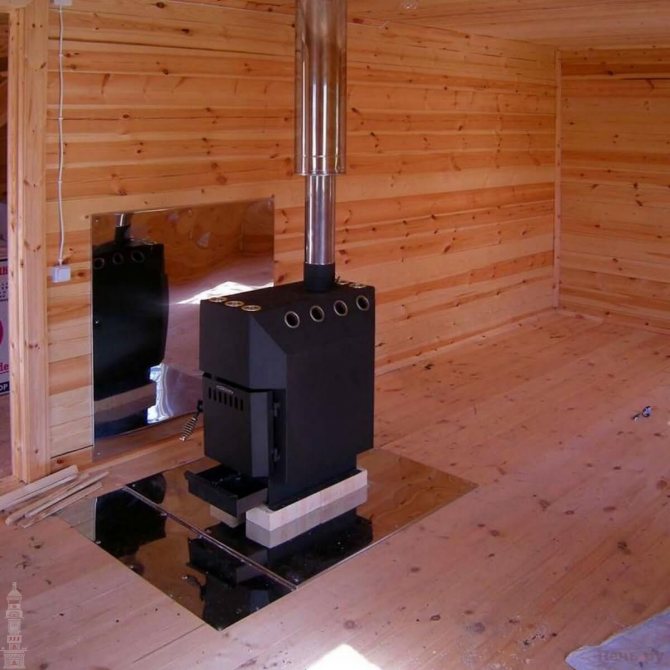

High school student with a hob
The model is characterized by the fact that its main purpose is cooking. In the upper part, a 49 kg hob is provided, which is not available on other models.
The chimney outlet is located in the same part of the body, taking up little space in the room. In addition to the declared advantages, this model also has disadvantages. One of them is that condensate and soot from a vertical pipe fall back into the furnace. It is very inconvenient to clean such a chimney, since before that it has to be completely dismantled.
Product characteristics:
- The declared power is 5 kW with an efficiency of 85%.
- The permissible volume of the room that can be heated is 50-100 m³.
- The dimensions of the furnace body are 400x500x500 mm with a weight of 34 kg.
- The volume of the furnace is 60 liters, and the diameter of the chimney is 115 mm.
Student
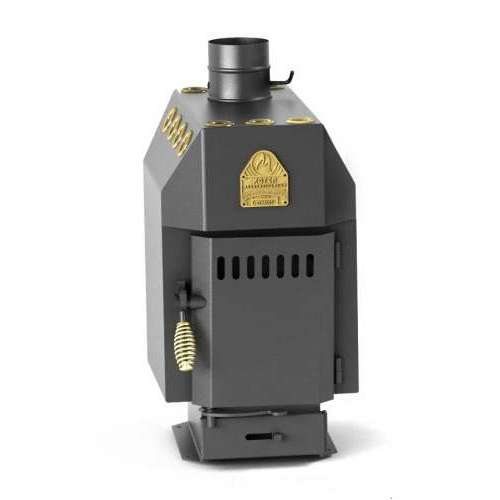

The student has a large pipe diameter
The model is considered to be one of the most common samples, optimally suited for summer cottages and well-insulated mansions. Heating stoves under this name are distinguished by a large pipe diameter and relatively thin walls, which make it possible to improve heat exchange with the outside environment.
The chimney outlet, mounted by means of a tee, is located at the rear of the body. This design allows you to clean it without removing it from the stove. To do this, it is enough to simply remove the bottom of the tee, in which the main masses of condensate and soot accumulate.In this part of the body there is a gate valve that allows you to adjust the draft, as well as a special fitting designed to remove condensate and dirt.
Model characteristics:
- Power - 9 kW with an efficiency of 85%.
- The size of the room that can be heated is 150 m³.
- With a weight of 57 kg, the dimensions of the furnace are 370x545x650 mm.
- The volume of the furnace is 74 liters, and the diameter of the branch pipes is 120 mm.
The varieties of the Student model differ only in cost: wood-burning with a steel door, coal with a metal-based sash and with a cast-iron door equipped with glass.
Engineer
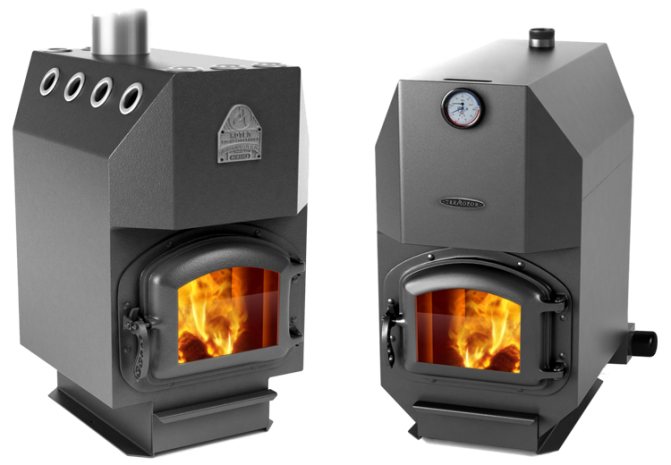

Engineer with heat resistant glass door
Furnaces of Professor Butakov of the Engineer type are among the more powerful and popular models, ideal for private homes and work sites. Like the Student, the structure contains enlarged convective tubes with thin walls.
Its characteristics:
- The power declared by the manufacturer is 15 kW with an efficiency of 85%.
- The volume of heated spaces - 250 m³;
- The volume of the firebox is 120 liters.
The pipe diameter of this product is 120 mm.
Assistant professor
The Docent oven is a further development of the previous models, distinguished by its capabilities and power. As a rule, it is used for heating mansions, cottages, as well as industrial and warehouse premises.
Technical specifications:
- Power equivalent to electric - 25 kW.
- The efficiency is 85 percent.
- The permissible volume of heated spaces is 500 m³.
- The volume of the firebox is 250 liters.
The stove has a 150 mm chimney.
Professor
Professor type stoves are the most powerful units from the entire presented model range. Their parameters:
- The maximum power is 40 kW.
- The size of the room that is heated with their help is 1000 m³.
- Weighing 57 kg, its dimensions are 670х1110х1250 mm.
The average pipe diameter of the Professor stove is 200 mm. The cost of individual modifications reaches 32,000 rubles.


Professor - heating area 1000 sq. m


Associate professor - heating area 500 sq. m
Design features of boilers
The boiler drum is an original type all-welded structure made of steel. Convection pipes crossing at the top are hermetically fixed between the top cover and the bottom of the body; straight convection pipes with open ends are similarly installed in the rear and front covers. The pipe system together with the body forms a combustion chamber. Gas guiding flaps are installed on the convection pipes crossing at the top, designed for uniform distribution of gas flows.
The door of the combustion chamber, rotating on hinges, opens 120 ° and has a cavity with a seal installed in it. The locking mechanism securely locks the door in the closed position by turning the handle.
The grate has the form of a chute, the accumulating ash in which protects the grate from overheating. This design of the furnace has an increased efficiency due to increased heat transfer in the combustion chamber.
Convection pipes allow the heated air to be quickly distributed throughout the room. The upper surface of the oven body can be used for cooking. (1.5 liters of water will boil in about 20 minutes).
The boiler is only adapted for the smoldering mode. It is not allowed to heat the heat-dissipating surfaces - the body and convective pipes - over 350 degrees Celsius! The fuel used in models with a metal door and protective screens is wood, coal, in models with a cast-iron door with heat-resistant glass - firewood.

